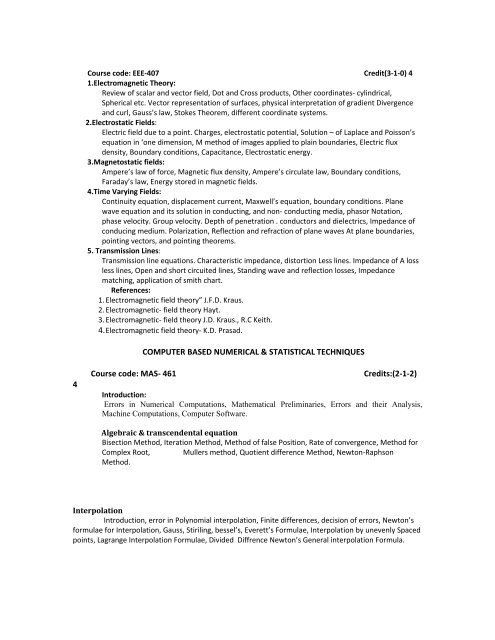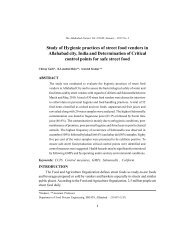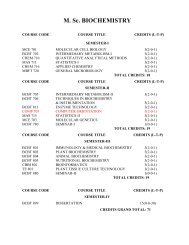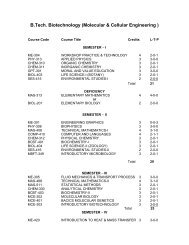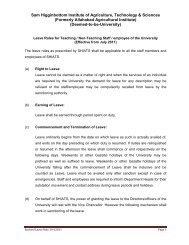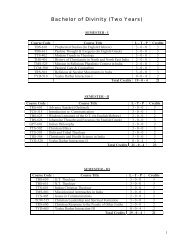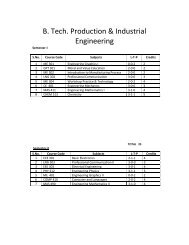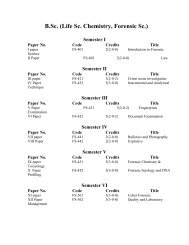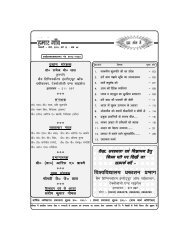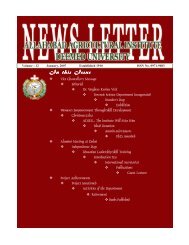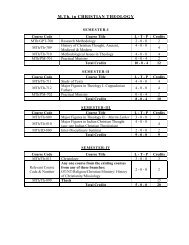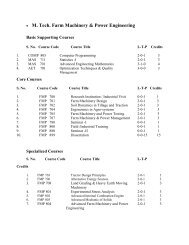B. Tech. Electrical Engineering - Shiats.edu.in
B. Tech. Electrical Engineering - Shiats.edu.in
B. Tech. Electrical Engineering - Shiats.edu.in
- No tags were found...
You also want an ePaper? Increase the reach of your titles
YUMPU automatically turns print PDFs into web optimized ePapers that Google loves.
Course code: EEE‐407 Credit(3‐1‐0) 41.Electromagnetic Theory:Review of scalar and vector field, Dot and Cross products, Other coord<strong>in</strong>ates‐ cyl<strong>in</strong>drical,Spherical etc. Vector representation of surfaces, physical <strong>in</strong>terpretation of gradient Divergenceand curl, Gauss’s law, Stokes Theorem, different coord<strong>in</strong>ate systems.2.Electrostatic Fields:Electric field due to a po<strong>in</strong>t. Charges, electrostatic potential, Solution – of Laplace and Poisson’sequation <strong>in</strong> ‘one dimension, M method of images applied to pla<strong>in</strong> boundaries, Electric fluxdensity, Boundary conditions, Capacitance, Electrostatic energy.3.Magnetostatic fields:Ampere’s law of force, Magnetic flux density, Ampere’s circulate law, Boundary conditions,Faraday’s law, Energy stored <strong>in</strong> magnetic fields.4.Time Vary<strong>in</strong>g Fields:Cont<strong>in</strong>uity equation, displacement current, Maxwell’s equation, boundary conditions. Planewave equation and its solution <strong>in</strong> conduct<strong>in</strong>g, and non‐ conduct<strong>in</strong>g media, phasor Notation,phase velocity. Group velocity. Depth of penetration . conductors and dielectrics, Impedance ofconduc<strong>in</strong>g medium. Polarization, Reflection and refraction of plane waves At plane boundaries,po<strong>in</strong>t<strong>in</strong>g vectors, and po<strong>in</strong>t<strong>in</strong>g theorems.5. Transmission L<strong>in</strong>es:Transmission l<strong>in</strong>e equations. Characteristic impedance, distortion Less l<strong>in</strong>es. Impedance of A lossless l<strong>in</strong>es, Open and short circuited l<strong>in</strong>es, Stand<strong>in</strong>g wave and reflection losses, Impedancematch<strong>in</strong>g, application of smith chart.References:1. Electromagnetic field theory” J.F.D. Kraus.2. Electromagnetic‐ field theory Hayt.3. Electromagnetic‐ field theory J.D. Kraus., R.C Keith.4. Electromagnetic field theory‐ K.D. Prasad.COMPUTER BASED NUMERICAL & STATISTICAL TECHNIQUES4Course code: MAS‐ 461Credits:(2‐1‐2)Introduction:Errors <strong>in</strong> Numerical Computations, Mathematical Prelim<strong>in</strong>aries, Errors and their Analysis,Mach<strong>in</strong>e Computations, Computer Software.Algebraic & transcendental equationBisection Method, Iteration Method, Method of false Position, Rate of convergence, Method forComplex Root, Mullers method, Quotient difference Method, Newton‐RaphsonMethod.InterpolationIntroduction, error <strong>in</strong> Polynomial <strong>in</strong>terpolation, F<strong>in</strong>ite differences, decision of errors, Newton’sformulae for Interpolation, Gauss, Stiril<strong>in</strong>g, bessel’s, Everett’s Formulae, Interpolation by unevenly Spacedpo<strong>in</strong>ts, Lagrange Interpolation Formulae, Divided Diffrence Newton’s General <strong>in</strong>terpolation Formula.


